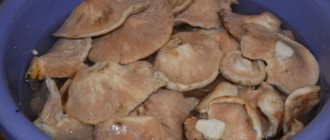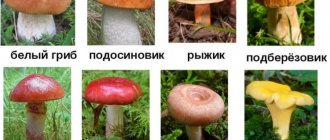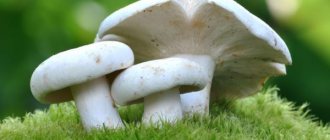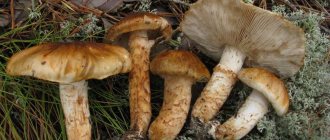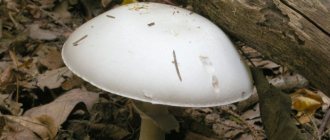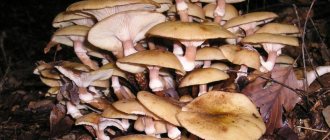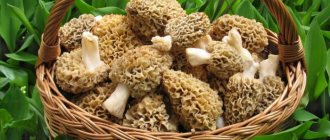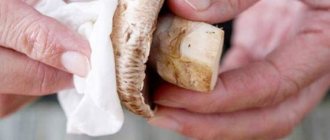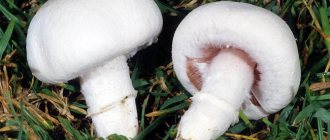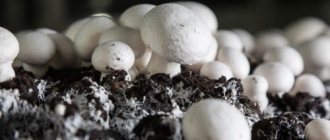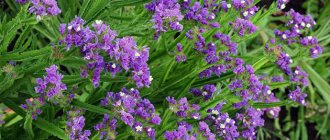Home Mushrooms
Existing types of champignons are divided into artificially cultivated and forest (wild) mushrooms. The former can be successfully grown in suitable conditions. But the types of forest champignons can easily be confused with their false counterparts and thereby harm your health. From the material on this page you can find out which types of champignons are edible, and how to correctly distinguish them from their false poisonous counterparts.
- 2 August types of edible champignons: photos and descriptions
- 3 Double-ringed type of champignons: photo and description
- 4 Forest champignon mushrooms: photo and description
- 5 Other champignon mushrooms: photos and descriptions
- 6 Field champignon
August types of edible champignons: photos and descriptions
August champignon in the photo
August champignon in the photo
August species of edible champignons can be eaten pickled, salted and fresh. The cap is 6-20 cm in diameter, in young specimens it is convex, creamy, yellowish, along the edge with the remains of a cover, then flat, the skin begins to crack, forming small rusty brown scales. The mushroom emerges from soft soil almost open with small particles of earth on the surface. The plates are loose, pink-gray, then brown. The leg is 10–18 cm long and 2–3 cm thick, covered with white flake-like scales with a white flake-like ring. Volva is missing. There is also no tuberous thickening in the lower part of the stalk. The white flesh turns brown when broken. There is an anise smell.
Look at these types of champignons in the photo and in the description: the information will make it easy to recognize them in the forest and collect them in your basket:
August species of edible champignons
August species of edible champignons
Grows in soil rich in organic matter in forests and fields.
Fruits in August - September.
Poisonous fly agarics can be distinguished from champignons by their completely white plates and the absence of a volva or tuberous thickening in the lower part of the stem.
Application in medicine
As for medicine, champignons are actively used here too. In particular, they can be consumed by people with diabetes, since mushrooms do not contain sugar. They are useful in the treatment of migraines, help relieve fatigue, and restore tone to the body. In addition, substances contained in mushrooms destroy cholesterol plaques and help prevent the development of tumors. Eating mushrooms reduces the likelihood of a heart attack and also prevents the development of atherosclerosis. Dried mushrooms are also useful, especially for stomach ulcers and hepatitis.
These mushrooms are actively used in cosmetology. The mushroom is believed to improve skin condition, preventing the appearance of wrinkles. Therefore, it is often included in cosmetic face masks.
Champignon is an amazing mushroom that is not only a wonderful nutritious product, but also has a number of other properties that are very valuable for humans. It is important to properly collect and store these gifts of nature, as well as to know about possible diseases of champignons so as not to cause harm to health. If you use them properly in cooking, cosmetology and medicine, you can enjoy their taste and beneficial qualities.
Double-ringed type of champignons: photo and description
Double-ringed type of champignons in the photo
The double-ringed champignon is edible. Description of the type of this champignon: the cap is 6-15 cm in diameter, convex in young specimens, then almost flat with a tucked edge, smooth or with radial cracks, white or brownish. The plates are loose, narrow, often pink, then chocolate brown. The leg is cylindrical, 4-9 cm long, smooth, white. Double ring in the middle of the leg. Volva is missing. The flesh is dense and slowly turns pink when cut or pressed.
Look at this type of champignon in the photo, which illustrates the process of growth and development of the fungus:
Double-ringed champignon in the photo
Double-ringed champignon in the photo
Grows in soil rich in organic matter. It grows in large quantities on city lawns, in dense soil along sidewalks. Sometimes it grows under the sidewalk, lifting the asphalt or spreading a crack in the road surface. It is called sidewalk champignon.
Fruits from July to October.
It looks like a poisonous yellow-skinned champignon (Agaricus xanhodermus), the flesh of which turns pink when cut and smells of carbolic acid.
Forest champignon mushrooms: photo and description
The forest champignon mushroom is edible.
We invite you to find out more information about forest champignons, and photos and descriptions will help you recognize them in the forest kingdom:
Forest champignon in the photo
Forest champignon in the photo
The cap is 4–9 cm in diameter, convex in young specimens, then flat-convex, almost white in pine forests, but more often light brown, covered with darker brown pointed scales. The plates are free, narrow, frequent, pink, then dark brown. The leg is cylindrical, 5-12 cm long, smooth, white, slightly scaly under the ring. The ring is white on the inside, matching the color of the cap on the outside. May be lost without traces on the stem. Volva is missing. The pulp is dense, pale carmine-red, with a mushroom smell, and turns red when cut and pressed. The forest champignon is similar to the August champignon, but has a more regular shape.
Look at the forest champignon mushrooms in the photo, which are offered further on this page:
Forest champignon mushroom in the photo
Grows in mixed and coniferous forests, in clearings. More often found in spruce forests.
Fruits from August to October.
It has no poisonous counterparts.
Suitable for all types of culinary processing. This is one of the most delicious edible, easily identified mushrooms.
Useful properties of pecheritsa
Pecheritsa are rich in protein, so they can replace meat. In addition to protein, they contain amino acids necessary for the normal functioning of the body, minerals and carbohydrates. Pecheritsa are also popular among nutritionists. Their KBZHU indicators (calorie content, the ratio of proteins, fats and carbohydrates) are as follows: calorie content is only 270 kcal per kg of product, and the glycemic index is 15 units. With such calorie content, pecheritsa have a high energy value. Few foods on the calorie table are this low and don't have this much energy value.
Fresh, boiled and baked products are low in calories. Dried pecheritsa contain 2-2.5 times more calories.
Pecheritsa are also record holders for the content of B vitamins. Medicine knows that they contain antioxidant properties and folic acid, which is necessary for women’s health. Pecheritsa are also rich in fiber and are good for high cholesterol.
There are currently discussions about the benefits of fresh pecheritsa. Of course, a fresh product contains much more useful substances than one that has been heat-treated. But the organism, which was grown with insecticides, can easily be poisoned. It is better to heat-treat purchased products. The taste of heat-treated pecheritsa is much better.
When cooking mushrooms, cut them rather than cook them whole, this will help determine whether the organism is edible. And only then it can be boiled, fried or stewed. Poached mushrooms are delicious, i.e. fried over low heat in butter for 5-7 minutes. Cooking and stewing do not exceed 15 minutes. Pecheritsa take a long time to digest, which is why you shouldn’t eat them at night.
Other champignon mushrooms: photos and descriptions
There are other champignon mushrooms, photos and descriptions of which can be found further on the page:
Champignon coppice
Field champignon
All of them grow in natural forest conditions in many regions of our country.
Champignon coppice
The mushroom is edible . The cap is 7-15 cm in diameter, convex in young specimens, then flat-convex, with white or beige scales, straw yellow or light beige. The plates are free, narrow, frequent, and in young mushrooms they are light pink, then chocolate brown. The leg is cylindrical, 5-10 cm long, smooth, light yellow, with a small tuberous expansion in the lower part. The ring is white, double, drooping, the inner layer of the ring has a jagged edge, its underside has scales. Volva is missing. The pulp is dense, white, with an almond or light anise odor; it turns yellow when cut and pressed.
It grows in mixed and coniferous forests and is a very common mushroom.
Fruits from August to October.
The coppice champignon is similar to the poisonous yellow-skinned champignon (Agaricus xantodermus), which smells like carbolic acid and has a smoother cap.
Evaluation of taste qualities, medicinal properties, benefits and possible harm
The calorie content of fresh pecheritsa is 27 kcal per 100 grams of product. Fresh mushrooms contain a whole list of vitamins B, E, PP and others. In addition, they also contain useful microelements: calcium, potassium, manganese, zinc, copper, iron, phosphorus, approximately 20 essential amino acids. The high-quality protein found in mushrooms is an excellent alternative to meat protein, which the body uses to build cells.
Other beneficial properties of champignons:
- normalization of the cardiovascular system;
- reducing the level of “bad” cholesterol in the blood;
- removes salts of heavy metals;
- Champignons contain antioxidant substances that fight free radicals.
- infusion of the mushroom is used to treat wounds;
- in the treatment of diabetes mellitus to reduce blood sugar levels;
- Traditional healers used extracts from pecheritsa to combat typhoid fever.
Reference! Experienced mushroom pickers claim that champignon extracts are an excellent antidote for snake bites.
Doctors warn that consuming any mushrooms is prohibited for children under 12 years of age, pregnant and lactating women, and people with exacerbations of chronic gastrointestinal diseases. Do not forget that champignons contain chitin (especially a lot of it in the legs), which is very difficult to digest. Mushrooms are a sponge; they quickly absorb heavy metal salts, pesticides and nitrates, and harmful substances. You should not collect champignons near major roads, plants and factories. This is not necessary, because today in stores there is a huge selection of safe pecheritsa grown in industrial conditions.
Field champignon
Field champignon in the photo
The mushroom is edible. The cap is 7-15 cm in diameter, convex in young specimens, then flat-convex, smooth white, turning yellow when pressed. The plates are free, frequent, in young mushrooms they are pale, gray-pink, then flesh-red, and black in old age. The leg is cylindrical, 6-15 cm long, 1-3 cm thick, smooth, white or light yellow, turns yellow when pressed, with a slight expansion in the lower part. The ring is white, ragged. Volva is missing. The pulp is dense, white, with a slight smell of anise; it turns yellow when cut and pressed.
It grows in mixed and coniferous forests, among bushes, in fields, pastures, near livestock pens, and in parks.
Fruits from July to October.
Field champignon is similar to the poisonous yellow-skinned champignon. (Agaricus xantodermus), which can be distinguished by the unpleasant smell of carbolic acid. The smell does not disappear after boiling the mushroom.
The mushroom is suitable for any type of culinary processing. The good thing is that you can get it in large quantities.
- Author: admin
Rate this article:
- 5
- 4
- 3
- 2
- 1
(16 votes, average: 4.8 out of 5)
Share with your friends!
